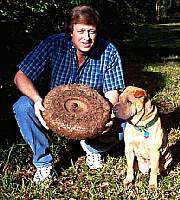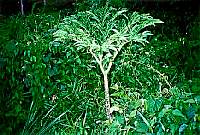Amorphophallus paeoniifolius (Dennst.) Nicolson
by Wilbert Hetterscheid
The information here in is adapted from W. Hetterscheid and S. Ittenbach, 1996,
Everything You Always Wanted to Know About Amorphophallus, but Were Afraid
to Stick Your Nose Into!!!!!, Aroideana
19: 7-131.
Amorphophallus paeoniifolius (Dennst.) Nicolson [Synonyms: A. campanulatus Decne (non Roxb.), A. dubius Bl., A. sativus Bl., A. decurrens (Blanco) Kunth, A. chatty Andre, A. virosus N.E.Br., A. rex Prain, A. malaccensis Ridl., A. gigantiflorus Hayata, A. microappendiculatus Engl., A. bangkokensis Gagnep., A. dixenii Lars. & Lars.].
Description: Tuber depressed-globose, to about 30 cm in diameter, about 20 cm high,
dark brown, root scars prominent, annulate, offsets produced every season, these thick rhizomatous, to about 10 cm
long, about 4 cm in diameter. Leaf solitary or two; petiole to about 2 meters long and about 20 cm in diameter, background
color pale to dark green or blackish green, usually with large
and small pale blotches and numerous tiny dark dots, the large
blotches often confluent, especially near the base, surface shallowly
corrugate to strongly echinate-verrucate; lamina highly dissected, to about 3 meters in diameter; leaflets rounded, oval, ovate, obovate, elliptic, elliptic-oblong, elliptic-lanceolate
or lanceolate, acuminate, 3 to 35 cm long, 2 to 12 cm in diameter,
upper surface midgreen, lower surface mid-green or pale green.
Inflorescence short-peduncled; peduncle 3 to 20 cm long, about 1 to 8 cm in diameter, usually paler and
smoother than petiole; spathe campanulate, broader than long, 10 to about 40 cm long, 15 to
about 60 cm in diameter, base and limb often separated by a shallow
constriction, limb spreading, strongly undulate, base outside
very variable, background color ranging from pale green to dark
brown, usually with large and small, circular paler spots, base
inside lower part deep maroon, upper zone dirty whitish or very
pale pinkish, limb outside as base but with more prominent maroon
flushes, especially near the margin, limb inside usually glossy
dark maroon, base within densely verrucate, verrucae variable,
mostly conical, fleshy. Spadix sessile, shorter or longer than spathe, 7 to about 70 cm long.
Distribution: Madagascar, eastwards via India to Malesia, southern China, Indochina,
Polynesia, northern Australia (in almost all imaginable secondary
conditions, either secondary forest or highly disturbed areas,
in dappled shade or fully exposed areas, altitude 0 to 700 meters).
Notes: The large number of synonyms presented here originates from many
an author's attempt to define a set of the variable characters
of A. paeoniifolius as supporting the separation of new species from the main body
of the species. The main body being specimens with large, pyramidal
appendices, very long styles, bilobed stigmas and fairly rough
petioles. Mostly the spadix is longer than the spathe but in inflorescences
developing from small tubers this is reversed, and occasionally
the appendix takes a more isodiametric shape, but this may also
be found in large specimens. The relative length of the female
zone compared to the male zone varies at random. The shape of
the male zone depends strongly on the width of the appendix base.
When the latter is large, the male zone is often roofed against
the underside of the appendix resulting in a strong obconic shape.
Alternatively, when the appendix base is narrow, the male zone
is cylindric or only slightly obconic. The degree of roughness
of the petiole may vary within one clone or specimen but is usually
constant. In certain areas roughness is ubiquitous (e.g. in Papua
New Guinea), but may vary from rough to near smooth (e.g. Java,
India). So far no correlation between any of these characters
has been found on a large scale. Amorphophallus paeoniifolius has a centuries old cultivation history in the Asian and Indopacific region and its natural distribution has been totally obscured because many specimens found in the wild are (probably) weedy escapees from cultivation. The closest relative of A. paeoniifolius is A. hirsutus.
Cultivation: Grow in any fertile soil. The tuber may be stored dry when dormant.
Click on the thumbnail images to view the larger images.
Images courtsey of Mary Sizemore and Scott Hyndman.
 This page was created by Scott E. Hyndman for the IAS on January 7, 1999. Graphics compliments of Lester Kallus.
This page was created by Scott E. Hyndman for the IAS on January 7, 1999. Graphics compliments of Lester Kallus.




 This page was created by
This page was created by